Ozarks Book Series
[SOLD OUT] An Environmental Journey: Tales of Tragedy and Hope from the Heartland
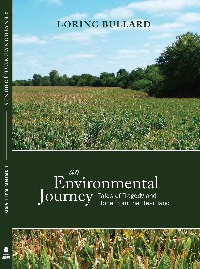 In his memoir, Loring Bullard reflects on his 73 years, from his 1950s and ’60s urban
and rural American childhood to the present day, all weaved seamlessly in with the
historical events that shaped him, the state of Missouri, the nation, and the world.
In 225 colorful pages, this book tackles the Cuban Missile Crisis, nuclear testing,
Earth Day, the contamination of Spring River and the ghost town of Times Beach, the
production of Agent Orange in Missouri, lead mining controversies in the eastern Ozarks,
rivers that caught fire, the rise of factory farming, legislative progress and setbacks,
and much more. Along the way, Bullard provides ideas and resources for protecting
the land, water, and air that we all share.
In his memoir, Loring Bullard reflects on his 73 years, from his 1950s and ’60s urban
and rural American childhood to the present day, all weaved seamlessly in with the
historical events that shaped him, the state of Missouri, the nation, and the world.
In 225 colorful pages, this book tackles the Cuban Missile Crisis, nuclear testing,
Earth Day, the contamination of Spring River and the ghost town of Times Beach, the
production of Agent Orange in Missouri, lead mining controversies in the eastern Ozarks,
rivers that caught fire, the rise of factory farming, legislative progress and setbacks,
and much more. Along the way, Bullard provides ideas and resources for protecting
the land, water, and air that we all share.
On the River: A History of the Ozarks Float Trip
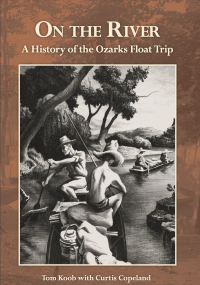
From humble beginnings when a knowledgeable guide could trade a creel full of fish for a fistful of dollars, the Ozarks float trip developed into a significant business model for outfitters who arranged multi-day floats for large groups and their mounds of gear down miles of free-flowing streams. The classic river expedition has now morphed into much shorter trips with mostly unguided groups or individuals floating with the current on the remaining untrammeled waterways of the Ozarks. In this volume, Tom Koob and Curtis Copeland explore the history of man's attraction to water and the story of the popular Ozarks float trip. On The River examines the guides, camps, outfitters and gear that spawned and grew the distinctive sport of floating the wild rivers and creeks of the Ozarks region. Complete with personal interviews, classic photographs and historic newspaper and magazine articles, readers will explore the allure, mystique, and wonderment of a sport that combined the ambitions of urban outlander sportsmen with the skills and camaraderie of rural mountain folk.
[SOLD OUT] Saving Bull Creek
 In the rugged Ozarks of southern Missouri, three creeks roughly align, flowing north-south
into the fabled, now dammed, White River: Beaver, Swan, and Bull Creek. The Bull Creek
watershed encompasses most of the land between the rapidly growing areas of Springfield
and Branson. Humans have lived here for millennia, although the earliest left few
traces. Illustrative of the watershed’s rough topography, the 19th century explorer,
Henry Rowe Schoolcraft, became lost in the tortuous valleys along Bull Creek. Settlers,
farmers, millers, lead miners, tie hackers, and hydroelectric engineers followed in
Schoolcraft’s footsteps, and later the roads bisecting the watershed, from the early
1800s Mail Trace to a modern four-lane highway. Loring Bullard and Robert Kipfer provide
a sensitive, multifaceted overview of the Bull Creek watershed, beautiful and durable,
but also under duress.
In the rugged Ozarks of southern Missouri, three creeks roughly align, flowing north-south
into the fabled, now dammed, White River: Beaver, Swan, and Bull Creek. The Bull Creek
watershed encompasses most of the land between the rapidly growing areas of Springfield
and Branson. Humans have lived here for millennia, although the earliest left few
traces. Illustrative of the watershed’s rough topography, the 19th century explorer,
Henry Rowe Schoolcraft, became lost in the tortuous valleys along Bull Creek. Settlers,
farmers, millers, lead miners, tie hackers, and hydroelectric engineers followed in
Schoolcraft’s footsteps, and later the roads bisecting the watershed, from the early
1800s Mail Trace to a modern four-lane highway. Loring Bullard and Robert Kipfer provide
a sensitive, multifaceted overview of the Bull Creek watershed, beautiful and durable,
but also under duress.
The Orbit of Meter: Writings on Poems and Prosody by Robert Wallace
 Robert Wallace (1932-1999) forged a distinguished career as a poet, teacher, editor,
and prosodist. Printed here for the first time, the monograph Free Verse and the Orbit of Meter mounts a rigorous defense of his original—and still controversial—theory of prosody
first outlined in the essay, “Meter in English,” which begins this volume. A native
Ozarker, Wallace was a prolific letter writer whose correspondents included John Updike,
Dana Gioia, Donald Hall, Ted Hughes, Linda Pastan, and Mary Oliver. The volume ends
with a descriptive inventory of his literary correspondence.
Robert Wallace (1932-1999) forged a distinguished career as a poet, teacher, editor,
and prosodist. Printed here for the first time, the monograph Free Verse and the Orbit of Meter mounts a rigorous defense of his original—and still controversial—theory of prosody
first outlined in the essay, “Meter in English,” which begins this volume. A native
Ozarker, Wallace was a prolific letter writer whose correspondents included John Updike,
Dana Gioia, Donald Hall, Ted Hughes, Linda Pastan, and Mary Oliver. The volume ends
with a descriptive inventory of his literary correspondence.
Ozarks Tales for Children: A Storytelling Handbook
 Finally a book of family-friendly folktales especially geared toward children. Here
you’ll find easy-to-learn animal tales, trickster tales, historical tales, tall tales,
jokes, games, and more! Teachers, parents, and those interested in passing along the
Ozarks heritage will find much to draw on in this volume. Illustrated by Ozarks school
children, the book is designed not only to delight the listener, but to encourage
children to tell the tales themselves. Includes sources for multicultural Ozarks tales,
as well.
Finally a book of family-friendly folktales especially geared toward children. Here
you’ll find easy-to-learn animal tales, trickster tales, historical tales, tall tales,
jokes, games, and more! Teachers, parents, and those interested in passing along the
Ozarks heritage will find much to draw on in this volume. Illustrated by Ozarks school
children, the book is designed not only to delight the listener, but to encourage
children to tell the tales themselves. Includes sources for multicultural Ozarks tales,
as well.
Author Cherri Jones has been a professional storyteller for over forty years. Close
to thirty of these have been spent in the Ozarks, giving her access to the tellers,
historians and library archives that led to this collection. As professor emeritus
and past director of the Curriculum Resource Center at Missouri State University’s
Meyer Library, Cherri has presented many workshops and courses to help beginning tellers
learn this age-old art.
Crystallofolia: Frost Flowers
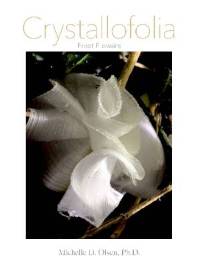 When Dr. Michelle Olsen stumbled upon frost flowers for the first time, she thought
they were trash. Peering closer, she discovered a unique Ozarks phenomenon—sculptures
of ice that extrude from the stems of the Verbesina virginica plant. Now in this photographic collection, Olsen takes readers up close, giving
them the chance to see what she saw and learn what she's learned along the way.
When Dr. Michelle Olsen stumbled upon frost flowers for the first time, she thought
they were trash. Peering closer, she discovered a unique Ozarks phenomenon—sculptures
of ice that extrude from the stems of the Verbesina virginica plant. Now in this photographic collection, Olsen takes readers up close, giving
them the chance to see what she saw and learn what she's learned along the way.
Michelle D. Olsen, Ph.D., is the Director of Institutional Research at Missouri State
University. A native of Montana, she resides in Springfield now, but has lived and
worked in many places, including at Apple Computer, Inc. in California. Her doctorate
is in Teaching and Learning in Higher Education, and she spent several years in the
classroom and writing curriculum. Her passion for the field comes through in this
nature volume, Crystallofolia: Frost Flowers.
This Life: An Autobiography
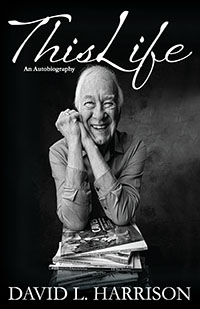 David L. Harrison is a native of Springfield, Missouri who has written over 100 children’s
books in poetry and prose. Now, in his new autobiography, the author takes us back
in time to his childhood and traces the evolution of a scientist turned writer. From
Missouri to Arizona to Kansas, all the way across the globe to Malaysia, and spanning
from the World War II era through 9/11 and on to the present, This Life chronicles the fits and starts, professional rejections and redirections, the inevitable
personal life conflicts and tragedies, as well as the breakthroughs and triumphs in
a career that has spanned seven decades…and is still going. Perfect for aspiring authors
and fans of Harrison’s work as well as anyone who enjoys a tale of hard work, perseverance,
and the joy of following your dreams.
David L. Harrison is a native of Springfield, Missouri who has written over 100 children’s
books in poetry and prose. Now, in his new autobiography, the author takes us back
in time to his childhood and traces the evolution of a scientist turned writer. From
Missouri to Arizona to Kansas, all the way across the globe to Malaysia, and spanning
from the World War II era through 9/11 and on to the present, This Life chronicles the fits and starts, professional rejections and redirections, the inevitable
personal life conflicts and tragedies, as well as the breakthroughs and triumphs in
a career that has spanned seven decades…and is still going. Perfect for aspiring authors
and fans of Harrison’s work as well as anyone who enjoys a tale of hard work, perseverance,
and the joy of following your dreams.
[SOLD OUT] Horton Smith: A Masters Legacy
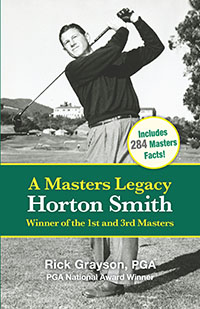 In 1962, the city of Springfield opened the Horton Smith Golf Course on the west side
of town. Its namesake returned to his hometown to cut the ribbon on that day in March,
shortly before he passed away. Smith's life was marked by athletic excellence, professional
triumph, and diplomacy during turbulent years in American (and sporting) history.
In Horton Smith: A Masters Legacy, author Rick Grayson tells modern readers how the two-time Masters Tournament champion
and PGA President navigated the racial divisions that were reaching a national boiling
point and the resulting tensions that were creeping onto the greens. In a time where
Smith’s character is being called into question, Grayson invites you to take another
look. Decide for yourself.
In 1962, the city of Springfield opened the Horton Smith Golf Course on the west side
of town. Its namesake returned to his hometown to cut the ribbon on that day in March,
shortly before he passed away. Smith's life was marked by athletic excellence, professional
triumph, and diplomacy during turbulent years in American (and sporting) history.
In Horton Smith: A Masters Legacy, author Rick Grayson tells modern readers how the two-time Masters Tournament champion
and PGA President navigated the racial divisions that were reaching a national boiling
point and the resulting tensions that were creeping onto the greens. In a time where
Smith’s character is being called into question, Grayson invites you to take another
look. Decide for yourself.
Rick Grayson is the Teaching Professional at the Rivercut Golf Course in Springfield,
Missouri. He has been a member of the PGA of America for 37 years and has taught over
10 high school state champions as well as players on the Korn Ferry Tour. He achieved
the PGA’s highest honor in 2011 by winning the PGA Junior Golf Leader award, the first
person from Springfield to win a national award since Horton Smith. He is a member
of the Missouri Sports Hall of Fame, PGA Midwest Section Hall of Fame, and the Ozarks
Golf Hall of Fame. In 2021, he received Golf Magazine’s Lifetime Achievement Award. This is his third book.
Jews of Missouri: An Ornament to Israel
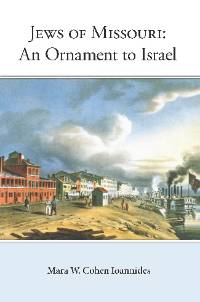 “Jews of Missouri” was written to reincorporate minorities into the history of the state. The book,
which focuses on pre-World War I, is divided into four parts. The first looks at the
creation of the state of Missouri. The second examines the history of Jews in the
United States and the state in broad terms, along with examining issues of concern
to the American Jewish community, like intermarriage, slavery and military service.
The third part presents the story of four Jewish families who spread across the state.
Finally, the appendix lists every town in Missouri that had a Jewish presence before
the first World War.
“Jews of Missouri” was written to reincorporate minorities into the history of the state. The book,
which focuses on pre-World War I, is divided into four parts. The first looks at the
creation of the state of Missouri. The second examines the history of Jews in the
United States and the state in broad terms, along with examining issues of concern
to the American Jewish community, like intermarriage, slavery and military service.
The third part presents the story of four Jewish families who spread across the state.
Finally, the appendix lists every town in Missouri that had a Jewish presence before
the first World War.
Mara W. Cohen Ioannides has studied the Jews of the Ozarks for more than two decades
with degrees from Columbia University, Carnegie Mellon University and The Spertus
Institute of Jewish Learning and Leadership. Mara is a faculty member of the English
Department at Missouri State University, and she is president of the Midwest Jewish
Studies Association and the Ozarks Studies Association. She is also the editor of
the “Greene County Historical Society Online Encyclopedia”.
“We Gave Them Thunder”
Marmaduke’s Raid and the Civil War in Missouri and Arkansas
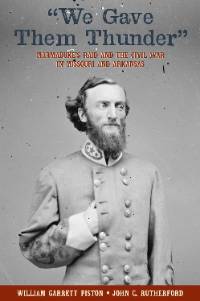 Written by William Garrett Piston, professor emeritus of history at Missouri State
and John C. Rutherford, local history associate at Springfield-Greene County Library,
“We Gave Them Thunder” is an authoritative study of Marmaduke’s raid into Southwest Missouri, the Battle
of Springfield (January 8, 1863), and the Battle of Hartville (January 11, 1863).
Written by William Garrett Piston, professor emeritus of history at Missouri State
and John C. Rutherford, local history associate at Springfield-Greene County Library,
“We Gave Them Thunder” is an authoritative study of Marmaduke’s raid into Southwest Missouri, the Battle
of Springfield (January 8, 1863), and the Battle of Hartville (January 11, 1863).
Piston and Rutherford have produced an impressive account of an important Civil War
military action in the Ozarks. If Gen. John S. Marmaduke’s forces had captured Springfield,
the ramifications would have influenced Union and Confederate operations far beyond
the loss of the largest and most important U.S. supply base in the region. It would
have affected Union morale and operations throughout southwest Missouri, into Northwest
Arkansas, up through Rolla, and to St. Louis. For the Confederates, beyond providing
them a wealth of rations, forage, horses, weapons, and other military items, it would
have reinforced their stature in Missouri, Arkansas and the Indian Territory (Oklahoma).
—Richard W. Hatcher III, Historian (ret.), Fort Sumter and Fort Moultrie National Historical Park, coauthor, The First Shot
Combining extensive research with astute analysis, Piston and Rutherford’s excellent study rescues General John S. Marmaduke’s “First Missouri Raid” from obscurity. Their even-handed narrative pays tribute to both the long-suffering Confederate raiders and to their tenacious Union opponents. This work should prompt students of the Civil War to turn their attention to the Trans-Mississippi West, where they will discover stories as compelling as the celebrated raids of Confederate commanders John Hunt Morgan and Jeb Stuart.
—Jeffrey L. Patrick, Museum Curator, Wilson’s Creek National Battlefield, author, Campaign for Wilson’s Creek
[SOLD OUT] Living Waters: Springs of Missouri
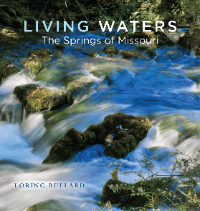 In Living Waters: The Springs of Missouri, Loring Bullard explores the rich variety of Missouri springs, placing them in the
state’s patterns of settlement and development. From the founding of towns to the
establishment of wagon-road rest stops to largely forgotten spas and resorts, Missouri
springs were, and continue to be, centerpieces of the landscape.
In Living Waters: The Springs of Missouri, Loring Bullard explores the rich variety of Missouri springs, placing them in the
state’s patterns of settlement and development. From the founding of towns to the
establishment of wagon-road rest stops to largely forgotten spas and resorts, Missouri
springs were, and continue to be, centerpieces of the landscape.
They were once cherished sources of drinking water, their purity unquestioned. They
provided power for mills, stock water for manufacturing plants, and source waters
for fish hatcheries. Their numbingly cold waters filled swimming pools and trout ponds
at scores of camps and resorts, where Missourians escaped the summer heat.
From the earliest times, springs were also sources of fascination. “Where does all that water come from? Why is it so cold?” Bullard gives us the science of spring hydrogeology; at the same time, he reminds us that springs were once revered symbols of renewal, purification, and everlasting life. They are no longer as central to the lives of Missourians. But are they still important to us? The answer to that question (and others) can be found in Living Waters.
TechnOzarks: Essays in Technology, Regional Economy, and Culture
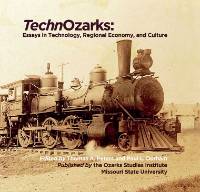 Edited by MSU Dean of Libraries, Thomas A. Peters, and Distinguished Professor of
Biology, Paul L. Durham, TechnOzarks is the latest publication of the Ozarks Studies Institute, an initiative of
the Missouri State University Libraries. Lavishly illustrated in hardcover, the book
supports the 2019 MSU Public Affairs Conference, theme, “The 21st Century Digital World.”
Edited by MSU Dean of Libraries, Thomas A. Peters, and Distinguished Professor of
Biology, Paul L. Durham, TechnOzarks is the latest publication of the Ozarks Studies Institute, an initiative of
the Missouri State University Libraries. Lavishly illustrated in hardcover, the book
supports the 2019 MSU Public Affairs Conference, theme, “The 21st Century Digital World.”
Peters, Thomas A., and Paul L. Durham, ed. TechnOzarks: Essays in Technology, Regional Economy, and Culture. Foreword by Greg Burris. OSI Studies in Ozarks History and Culture Vol. 2. Springfield,
MO: Ozarks Studies Institute, 2019. lii + 296 pp. with 248 b/w and color illustrations.
As the book’s publisher, the Ozarks Studies Institute (OSI) seeks to preserve the heritage of the Ozarks, its culture, environment, and history. The Institute promotes a sense of place for residents and visitors alike and serves as an educational resource by collecting existing—and discovering new—knowledge about the Ozarks and by providing access to that knowledge. Its essays and photo albums divide into three sections.
The first section, “Regional History through the Mid-Twentieth Century,” recounts the conquest of the rugged Ozarks terrain (by railroad, automobile, and hydroelectricity) and the development of “big machine” industry. The second section, “From the Later Twentieth Century to the Present,” explores communication technologies in radio and television (which made Springfield, for a time, the epicenter of country music broadcasting in America); other themes include urban Springfield’s transition from an industrial to a service economy and the transformation of the “lake country” landscape through tourism. The third section, “The Twenty-First Century and Beyond,” celebrates the region’s successful wedding of technology and entrepreneurship, ensuring the Ozarks a place in the emerging global economy; also featured is “A Forum on the Future,” in which scientists, academicians, healthcare practitioners, men and women of business, and citizens of diverse backgrounds make their predictions—and say what they are doing, now, to ensure a hopeful future for Springfield and the Ozarks.
Living Ozarks: The Ecology of a Natural Place
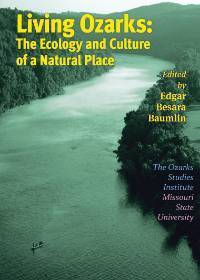 Lavishly illustrated, Living Ozarks: The Ecology and Culture of a Natural Place brings together essays, journal articles, book excerpts, and art/photo albums, all
themed around the region's heritage of nature and culture intertwined. Featured among
the artwork are botanical drawings of S. Fred Prince, arguably the Ozarks' first scientific
illustrator; the “outsider art” of S.W. Mannon, one of the last “Shepherd of the Hills”
pioneers (whose cabin is now an attraction at Silver Dollar City theme park); and
internationally renowned photographer Jacek Fraczak. Readers familiar with the Ozarks'
tradition of nature writing will recognize many of the names anthologized, including
Leonard Hall, Milton Rafferty, Robert Flanders, Werner O. Nagel, Robert K. Gilmore,
and Dan Saults. Section topics include Defining the Ozarks, Eras of the Ozarks, Sustainability
in the Ozarks, The Ozarks as Wilderness, and Experiencing the Ozarks.
Lavishly illustrated, Living Ozarks: The Ecology and Culture of a Natural Place brings together essays, journal articles, book excerpts, and art/photo albums, all
themed around the region's heritage of nature and culture intertwined. Featured among
the artwork are botanical drawings of S. Fred Prince, arguably the Ozarks' first scientific
illustrator; the “outsider art” of S.W. Mannon, one of the last “Shepherd of the Hills”
pioneers (whose cabin is now an attraction at Silver Dollar City theme park); and
internationally renowned photographer Jacek Fraczak. Readers familiar with the Ozarks'
tradition of nature writing will recognize many of the names anthologized, including
Leonard Hall, Milton Rafferty, Robert Flanders, Werner O. Nagel, Robert K. Gilmore,
and Dan Saults. Section topics include Defining the Ozarks, Eras of the Ozarks, Sustainability
in the Ozarks, The Ozarks as Wilderness, and Experiencing the Ozarks.
As our national dialogue turns with increasing urgency toward issues of ecology and sustainable practices in business, land and water use, and lifestyle, an anthology like Living Ozarks offers important historical-cultural contexts. As Missouri State University President Clif Smart writes in his foreword, “The historical texts and images show where we have come from; the contemporary texts and images give suggestions as to where we've arrived and how we might move forward—our collective task being to ensure that the Ozarks remains a place of health, beauty, richness, and wonder for future generations.”